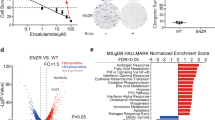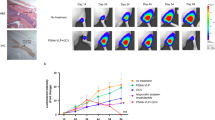Abstract
We previously demonstrated that the downregulation of Casitas B-lineage lymphoma (c-Cbl) can sensitize tumor necrosis factor-related apoptosis-inducing ligand (TRAIL)-induced apoptosis in two different ways. One way is to block the rapid degradation of TRAIL receptors, which can sustain TRAIL-induced apoptosis for a long time. Here, we designed a replication-defective adenovirus expressing the short hairpin RNA (shRNA) against c-Cbl to test the possibility of developing a cancer gene therapy that can act as a sensitizer of TRAIL. As expected from the results of our previous study that used a stable cell line with downregulated c-Cbl, infection with the c-Cbl shRNA-expressing adenovirus led to an increase in the death receptor 4 (DR4) and DR5 levels, which is known to be a cause for the increase of TRAIL-induced apoptosis. In conclusion, we demonstrated that c-Cbl shRNA-expressing adenovirus is able to sensitize TRAIL-induced apoptosis in vivo as well as in vitro.
This is a preview of subscription content, access via your institution
Access options
Subscribe to this journal
Receive 12 print issues and online access
$259.00 per year
only $21.58 per issue
Buy this article
- Purchase on Springer Link
- Instant access to full article PDF
Prices may be subject to local taxes which are calculated during checkout




Similar content being viewed by others
Abbreviations
- DR4/5:
-
death receptor 4/5
- PARP:
-
poly (ADP-ribose) polymerase
- PBS:
-
phosphate-buffered saline
- RNASEH2A:
-
ribonuclease H2 subunit A
- TRAIL:
-
tumor necrosis factor-related apoptosis-inducing ligand
References
Soubeyran P, Kowanetz K, Szymkiewicz I, Langdon WY, Dikic I . Cbl-CIN85-endophilin complex mediates ligand-induced downregulation of EGF receptors. Nature 2002; 416: 183–187.
Thien CB, Langdon WY . Cbl: many adaptations to regulate protein tyrosine kinases. Nat Rev Mol Cell Biol 2001; 2: 294–307.
Dikic I, Szymkiewicz I, Soubeyran P . Cbl signaling networks in the regulation of cell function. Cell Mol Life Sci 2003; 60: 1805–1827.
Keane MM, Rivero-Lezcano OM, Mitchell JA, Robbins KC, Lipkowitz S . Cloning and characterization of cbl-b: a SH3 binding protein with homology to the c-cbl proto-oncogene. Oncogene 1995; 10: 2367–2377.
Kim M, Tezuka T, Suziki Y, Sugano S, Hirai M, Yamamoto T . Molecular cloning and characterization of a novel cbl-family gene, cbl-c. Gene 1999; 239: 145–154.
Keane MM, Ettenberg SA, Nau MM, Banerjee P, Cuello M, Penninger J et al. cbl-3: a new mammalian cbl family protein. Oncogene 1999; 18: 3365–3375.
Thien CB, Langdon WY . c-Cbl and Cbl-b ubiquitin ligases: substrate diversity and the negative regulation of signalling responses. Biochem J 2005; 391 (Part 2): 153–166.
Song JJ, Szczepanski MJ, Kim SY, Kim JH, An JY, Kwon YT et al. c-Cbl-mediated degradation of TRAIL receptors is responsible for the development of the early phase of TRAIL resistance. Cell Signal 2010; 22: 553–563.
Song JJ, Kim JH, Sun BK, Alcala MA, Bartlett DL, Lee YJ . c-Cbl acts as a mediator of Src-induced activation of the PI3K-Akt signal transduction pathway during TRAIL treatment. Cell Signal 2010; 22: 377–385.
Yan S, Qu X, Xu C, Zhu Z, Zhang L, Xu L et al. Down-regulation of Cbl-b by bufalin results in up-regulation of DR4/DR5 and sensitization of TRAIL-induced apoptosis in breast cancer cells. J Cancer Res Clin Oncol 2012; 138: 1279–1289.
McAnuff MA, Rettig GR, Rice KG . Potency of siRNA versus shRNA mediated knockdown in vivo. J Pharm Sci 2007; 96: 2922–2930.
Berkner KL . Development of adenovirus vectors for the expression of heterologous genes. BioTechniques 1988; 6: 616–629.
Sharma A, Tandon M, Bangari DS, Mittal SK . Adenoviral vector-based strategies for cancer therapy. Curr Drug Ther 2009; 4: 117–138.
Brummelkamp TR, Bernards R, Agami R . A system for stable expression of short interfering RNAs in mammalian cells. Science 2002; 296: 550–553.
Schopman NC, Liu YP, Konstantinova P, ter Brake O, Berkhout B . Optimization of shRNA inhibitors by variation of the terminal loop sequence. Antiviral Res 2010; 86: 204–211.
Sioud M . Promises and challenges in developing RNAi as a research tool and therapy. Methods Mol Biol 2011; 703: 173–187.
Purev E, Neff L, Horne WC, Baron R . c-Cbl and Cbl-b act redundantly to protect osteoclasts from apoptosis and to displace HDAC6 from beta-tubulin, stabilizing microtubules and podosomes. Mol Biol Cell 2009; 20: 4021–4030.
Engelman JA . Targeting PI3K signalling in cancer: opportunities, challenges and limitations. Nat Rev Cancer 2009; 9: 550–562.
Mendoza MC, Er EE, Blenis J . The Ras-ERK and PI3K-mTOR pathways: cross-talk and compensation. Trends Biochem Sci 2011; 36: 320–328.
Acknowledgements
This work was supported by the Industrial Strategic Technology Development program (10035562: Development of nucleic acid-based anticancer drugs overcoming the immunotherapy resistance) funded by the Ministry of Knowledge Economy (MKE, Korea). This work was also supported by the Basic Science Research Program through the National Research Foundation of Korea (NRF) and funded by the Ministry of Education, Science and Technology (2012-0002108; JJ Song) and by a faculty research grant of Yonsei University College of Medicine for 2011 (6-2011-0099). Y Kim is funded by the Brain Korea 21 project for Medical Science, Yonsei University, College of Medicine, Seoul, Republic of Korea.
Author information
Authors and Affiliations
Corresponding author
Ethics declarations
Competing interests
The authors declare no conflict of interest.
Rights and permissions
About this article
Cite this article
Kim, S., Kim, JH. & Song, J. c-Cbl shRNA-expressing adenovirus sensitizes TRAIL-induced apoptosis in prostate cancer DU-145 through increases of DR4/5. Cancer Gene Ther 20, 82–87 (2013). https://doi.org/10.1038/cgt.2012.88
Received:
Revised:
Accepted:
Published:
Issue Date:
DOI: https://doi.org/10.1038/cgt.2012.88
Keywords
This article is cited by
-
Inflammatory bowel disease-associated ubiquitin ligase RNF183 promotes lysosomal degradation of DR5 and TRAIL-induced caspase activation
Scientific Reports (2019)
-
Elucidation for modulation of death receptor (DR) 5 to strengthen apoptotic signals in cancer cells
Archives of Pharmacal Research (2019)
-
The proteasome deubiquitinase inhibitor b-AP15 enhances DR5 activation-induced apoptosis through stabilizing DR5
Scientific Reports (2017)
-
Chloroquine enhances TRAIL-mediated apoptosis through up-regulation of DR5 by stabilization of mRNA and protein in cancer cells
Scientific Reports (2016)



